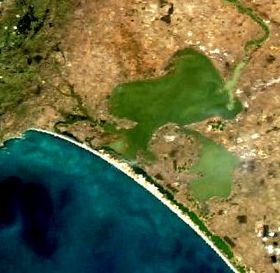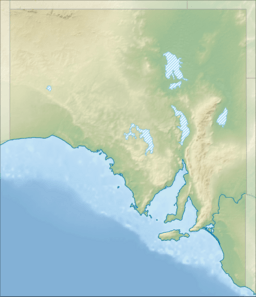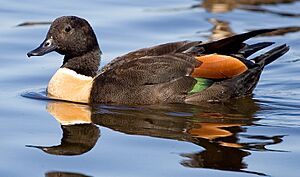Lake Alexandrina (South Australia) facts for kids
Quick facts for kids Lake Alexandrina |
|
|---|---|

Lake Alexandrina is the larger lake to the left. Lake Albert is the smaller lake to the right.
|
|
| Location | South Australia |
| Coordinates | 35°27′S 139°09′E / 35.450°S 139.150°E |
| Type | Freshwater |
| Primary inflows | Murray, Bremer, Angas, and Finniss Rivers |
| Primary outflows | Murray Mouth |
| Catchment area | 1,061,469 km2 (409,835 sq mi) |
| Basin countries | Australia |
| Surface area | 64,900 ha (251 sq mi) |
| Average depth | 2.8 m (9.2 ft) |
| Max. depth | 6 m (20 ft) |
| Water volume | 1,610 GL (430×109 US gal; 350×109 imp gal) |
| Surface elevation | 0.75 m (2.5 ft) |
| Settlements | Clayton Bay, Milang, Raukkan |
| Official name: The Coorong, Lake Alexandrina & Albert Wetland | |
| Designated: | 1 November 1985 |
| Reference #: | 321 |
Lake Alexandrina is a large freshwater lake in South Australia, about 100 kilometers (62 miles) south-east of Adelaide. It's located between the Fleurieu and Kangaroo Island and Murray and Mallee areas. The lake is connected to the smaller Lake Albert. Together, they are known as the Lower Lakes.
Lake Alexandrina also connects to a coastal lagoon called The Coorong. From there, its water flows into the Great Australian Bight through a narrow opening called the Murray Mouth.
Contents
What's in a Name?
Aboriginal Names
Aboriginal people who lived near the lake had different names for it. Some of these names included Mungkuli, Parnka, and Kayinga.
European Names
English settlers named the lake after Princess Alexandrina. She was the niece of King William IV of Great Britain and Ireland and later became Queen Victoria. When she became queen, some people thought about changing the lake's name to Lake Victoria, but they decided not to.
About Lake Alexandrina
Lake Alexandrina is located north of Encounter Bay and east of Fleurieu Peninsula. The main river that flows into Lake Alexandrina is the Murray River. Other rivers like the Bremer, Angas, and Finniss also feed into it. These rivers come from the eastern side of the southern Mount Lofty Ranges.
The lake is quite shallow and has several islands, especially near its southern end. Loveday Bay is an inlet on the south-east side of the lake. Lake Alexandrina is linked to the smaller Lake Albert by a narrow channel.
The lake's water flows into the Southern Ocean through the Murray Mouth. This is south-east of the town of Goolwa. Sometimes, when the river doesn't have much water, a sand-bar can block the mouth.
Long ago, seawater from the ocean could flow into the lake. But now, a series of barrages called the Goolwa Barrages keep the lake as freshwater. These barrages cross five channels between the mainland and three islands near the Murray Mouth.
Studies have shown that Lake Alexandrina was mostly a freshwater ecosystem before Europeans arrived. Even when it was connected to the ocean, the fresh and salt water didn't mix much.
Hindmarsh Island, located near the lake, is known for having salt water on one side and fresh water on the other.
History of the Lake
In Aboriginal mythology, a monster called the Muldjewangk was believed to live in the lake.
In the 1850s, a journalist named Edward Wilson visited the lake. He wrote that it was "the finest sheet of fresh water I ever saw." He was surprised it was freshwater because it looked so big, like the ocean. He noted that the lake's water had a muddy color from the Murray River.
The Point McLeay mission was started by George Taplin on the lake's shore in 1859. It became an Aboriginal reserve in 1916. In 1974, it was given back to the Ngarrindjeri people and renamed Raukkan in 1982. David Unaipon, a famous inventor and author, came from Raukkan.
Around 2008, the water levels in Lake Alexandrina and Lake Albert became very low. This created a risk of acid sulphate soils forming. These soils have iron sulphides. When they are exposed to air, they can create sulphuric acid. The Goolwa Barrages now prevent seawater from flowing in, which used to stop this problem during droughts.
Lake Environment
Many animals live in and around Lake Alexandrina. Turtles live in the lake, and lizards and snakes can be found along the shore. You might also see insects like dragonflies, moths, butterflies, and many types of beetles. Freshwater fish, including the introduced European carp, live in the lake.
The land around the lake doesn't have a lot of organic carbon. However, good crops like barley and vegetables can still grow there.
Birds of the Lake
Lake Alexandrina is a very important home for many types of waterbirds. This includes migratory waders (shorebirds) that travel all the way from northern Asia and Alaska.
Some of the special birds found here include:
- The critically endangered orange-bellied parrot
- The endangered Australasian bittern
- The vulnerable fairy tern
The lake also supports more than 1% of the world's population of:
Protected Status
Lake Alexandrina is part of a special protected area called "The Coorong, Lake Alexandrina & Albert Wetland." It was recognized as a Ramsar site on November 1, 1985. Ramsar sites are wetlands that are important internationally for their unique plants and animals.
See also
 In Spanish: Lago Alexandrina para niños
In Spanish: Lago Alexandrina para niños



